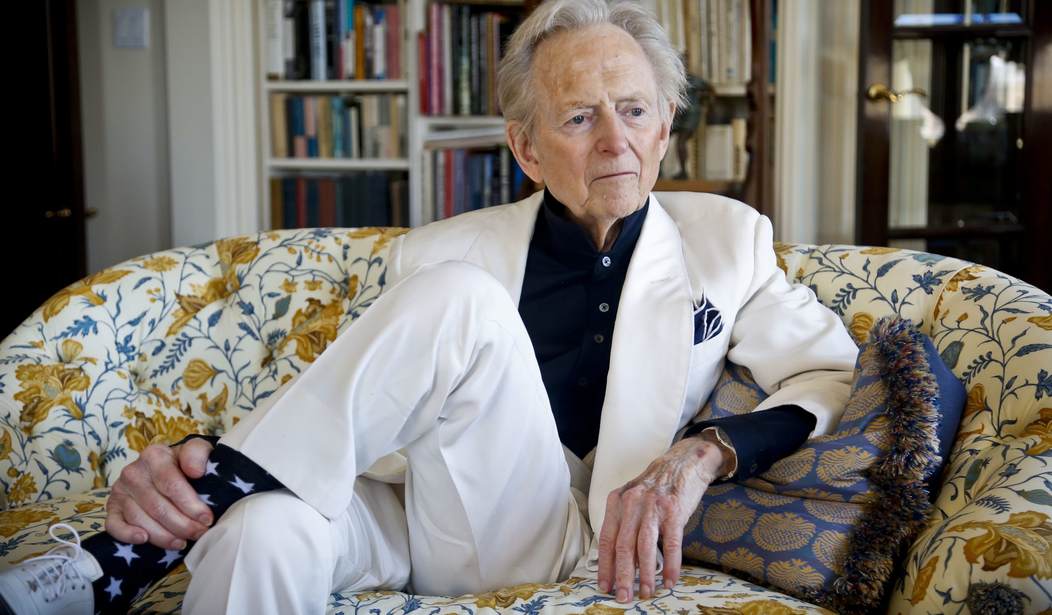Tom Wolfe, one of the brightest American literary lights of the 20th century (and the beginning of the 21st), has passed away at a hospital in Manhattan after an infection. He was 88.
Wolfe was a prolific writer, penning 13 non-fiction works and four novels, along with countless magazine essays, and he received dozens of awards and honorary degrees in his six-decade career. A Virginia native, he attended Washington & Lee University, where his graduate thesis demonstrated the iconoclastic writing technique that would serve him well over the years.
After a three-day stint as a professional baseball pitcher, Wolfe pursued both a PhD and a career in journalism. Both his doctoral thesis and his early journalism reflected his unwillingness to simply be an objective writer.
An article about California’s hot rod culture in Esquire led to his first book, the essay collection The Kandy-Kolored Tangerine-Flake Streamline Baby, a book that combined straightforward reporting with clever wordplay, sly wit, and creative terminology and punctuation. With it, Wolfe became one of the leading practitioners of the New Journalism — the blending of traditional journalism with literary styles.
In the ’80s, Wolfe added fiction to his repertoire with The Bonfire of the Vanities. Wolfe’s novels were expansive, epic tomes full of evocative detail and social commentary. From the rat race of New York yuppies to the pitfalls of higher education to the social strata of the modern South, Wolfe covered so many mores of American life in his fiction.
But it’s Wolfe’s nonfiction work that remained his bread and butter. Perhaps the general public knows him best for The Right Stuff, the chronicle of test pilots and how they morphed into the early space program which became an Oscar-nominated film. I remember having to read it in either high school or college and not enjoying it — probably because it was required reading.
For me, Wolfe was at his best when he was skewering the cultural and political landscape. My favorite of his was that evisceration of modern architecture, From Bauhaus to Our House. In it, he examines the self-righteousness of modern architects and how an adoring academia fell at their feet, leaving glass boxes and boring mid-century buildings in their wake. As he wrote:
Among the architecture students in the universities the International Style was all you heard about. Enthusiasm had been building up ever since the pilgrims had returned from Europe and the Museum of Modern Art began touting the compound architects. When the white gods suddenly arrived, enthusiasm became conversion, in the religious sense. There was a zeal about it that went quite beyond the ordinary passions of aesthetic taste. It was the esoteric, hierophantic fervor of the compound that seized them all. “Henceforth, the divinity of art and the authority of taste reside here with us . . .”
…and…
Every great law firm in New York moves without a sputter of protest into a glass-box office building with concrete slab floors and seven-foot-ten-inch-high concrete slab ceilings… Without a peep they move in!–even though the glass box appalls them all.
And then there’s the juggernaut that is Radical Chic & Mau-Mauing the Flak Catchers. In “Radical Chic,” the first half of the twin-essay volume, Wolfe pokes at the swanky liberalism of the New York jet set, in which glittering, lily-white liberals gather at a fundraiser for the Black Panther Party, while the second essay looks at how certain elements of the left intimidate bureaucrats. Oddly enough, while Wolfe eschewed political labels, he often saved his pointiest barbs for the left and even supported George W. Bush in 2004. William F. Buckley, Jr. once lionized Wolfe as “probably the most skillful writer in America — I mean by that he can do more things with words than anyone else.”
Tom Wolfe carried a reputation as a fashion maverick nearly as much as that of a literary titan. He wore his trademark white suit at virtually every public appearance. As the New York Times put it:
He was instantly recognizable as he strolled down Madison Avenue — a tall, slender, blue-eyed, still boyish-looking man in his spotless three-piece vanilla bespoke suit, pinstriped silk shirt with a starched white high collar, bright handkerchief peeking from his breast pocket, watch on a fob, faux spats and white shoes. Once asked to describe his get-up, Mr. Wolfe replied brightly, “Neo-pretentious.”
Rest in peace, Tom Wolfe. There will never be another author quite like you, and generations of readers and lovers of the written word will always be grateful for you.










Join the conversation as a VIP Member